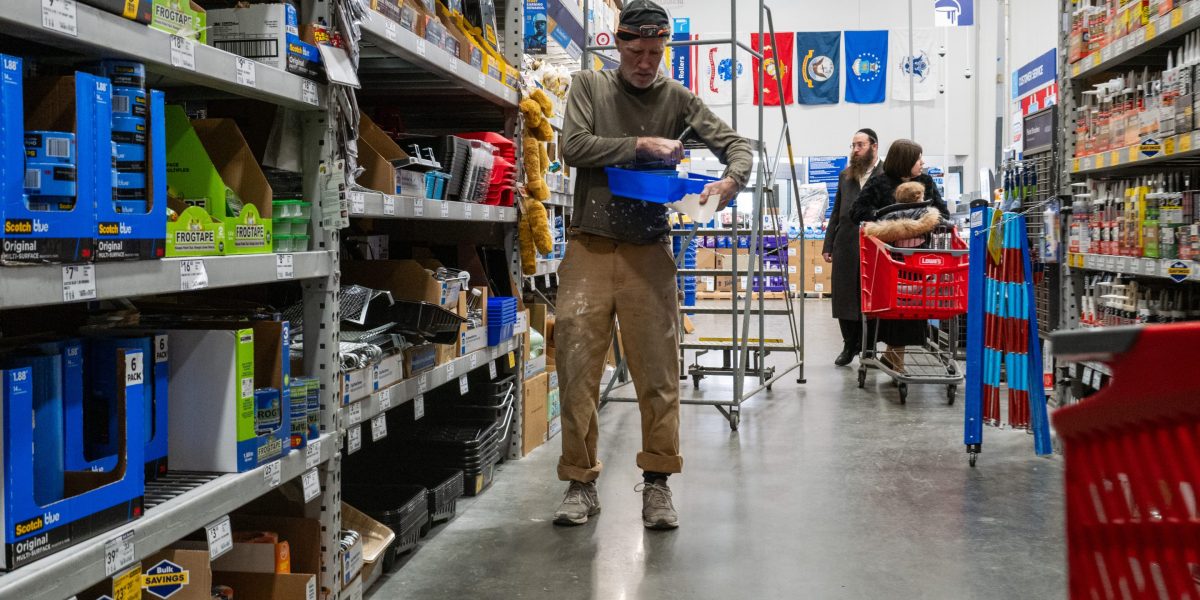

When mortgage rates are so high that no one can buy a house or refinance a mortgage, people also stop grouting, painting, and tiling—all the do-it-yourself renovations necessary to shape up your house for sale.
This is leading to serious pain for retailers. Lowe’s reported Wednesday a 5.1% comparable sales decline in its second quarter ending in early August. It expects retail operation sales to fall 3.5% to 4% this year compared to previous estimates of a 2% to 3% decline. The DIY slowdown at Lowe’s mirrors that of rival Home Depot, which slashed its sales guidance after weakened second-quarter sales. It now expects comparable sales to fall 3% to 4% this year, a humbling prospect for the largest retail home improvement and construction supply company in the world, compared to its initial prediction of a 1% decline.
Lowe’s and Home Depot, with a combined 4,000-plus locations across the U.S., admitted to biding their time, hoping that an expected interest rate cut would mean customers warming back up to the idea of donning protective goggles and gloves to finally redo their countertops.
“We’re all aware that we have an environment of elevated interest rates and inflation,” Lowe’s CEO Marvin Ellison said. “And because of that, the DIY customer is just on the sidelines, waiting for some form of an inflection to take place.”
Indeed, mortgage rates have fallen to their lowest in a year, but reprieve for home improvement stores can’t come soon enough. DIY spending usually peaks six months to a year after a new move, according to GlobalData retail managing director Neil Saunders. So even if mortgage rates become more favorable, amateur reno projects could be on hold until well into 2025, a trend reflected in Harvard University’s Joint Center for Housing Studies, which projects a steady increase in spending on housing repairs heading into next year.
Accordingly, Ellison attributed the sales slump in large part to less interest in big discretionary purchases for kitchen, bathroom, and flooring projects—a continuation of a trend noticed late last year. He said poor weather was also to blame, as “wetter weather in May was quickly followed by intense heat across much of the country in June and July,” disrupting the usual spring and summer purchases of patio furniture and lawn care.
“We’re still roughly approximately 75% DIY. So, any pullback in these big-ticket discretionary categories is really more of a disproportionate impact to us,” Ellison said during the earnings call.
Home Depot had a similar take. “During the quarter, higher interest rates and greater macroeconomic uncertainty pressured consumer demand more broadly, resulting in weaker spend across home improvement projects,” chair, president, and CEO Ted Decker said.
Contending with the highest home prices in almost 20 years, prospective homebuyers have effectively been shut out of the market. While fewer new homeowners means less opportunity for fixer-upper renovations, the home-improvement industry could get a one-two punch from the lock-in effect: Would-be sellers graced with ultralow mortgage rates as a result of the pandemic are less interested in putting their houses on the market. That means less motivation and less opportunity to complete last-minute projects before putting their homes up on the market, another blow to DIY.
Trading procrastinators for pro contractors
Lowe’s and Home Depot have avoided just playing the waiting game by becoming a haven for professional contractors. Home Depot CEO Decker said earlier this year the addressable market for contractors could swell to $250 billion. The retailer gets about half of its customer base from professional contractors. It has focused on developing its “Pro Ecosystem” through the March acquisition of SRS Distribution, which expands its distribution network and ability to carry professional-friendly inventory.
Lowe’s, which made a similar switch to contractor-centered sales through loyalty programs and order deliveries to renovation sites, is already seeing the benefits in the investment. Its quarterly dip was offset by a mid-single-digit increase in same-store sales and 2.9% increase in online pro sales.
“One thing we can confirm for sure is that our Pro business is growing,” Ellison said.
And until homeowners are ready to pick up the power tools again, Ellison believes Lowe’s can weather the storm.
“Although we are unable to call the date for the recovery in home improvement, we are confident that we’ll be in a strong position to take share when the market begins to inflect,” he said.















